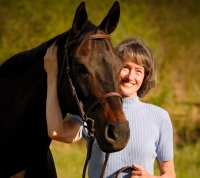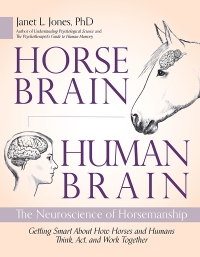TRUE TRAINING 79 - Complex Aids, or "You Want What?"
Mr. True North outdid himself this week! With a series of calm attentive rides, he finally mastered the art of distinguishing between aids for the leg yield and aids for the canter depart. This marks the beginning of his realization that riders’ signals become increasingly complicated. They will require more of his attention and will lead to his ability to perform more difficult movements.
Clarifying the meaning of various aids in the horse’s mind is a difficult process. At the beginning, young horses have no idea which signals a rider might use to represent a given maneuver. They don’t even know that signals have a meaning!
That’s why we start with the basics—a release of hand pressure accompanied by an increase of pressure from both legs means “move forward.” From there, we add simple signals like touching one rein to signify a turn, or touching both reins and reducing leg pressure to signify a stop, and so on.
At first with babies, including True, I offer signals that are quite distinct from each other. This reduces confusion in the horse’s mind and allows him to be successful, receiving non-edible rewards for good work. That in turn motivates the little guy to try to decipher signal meaning and offer the correct response. Many of my early posts in this blog discuss the basic signalling patterns for stop, go, walk, trot, canter, and back. True has mastered them all.
But as True learns more complex maneuvers, sometimes I have to use signals that aren’t so easily distinguished. A great example is the leg yield. In a leg yield, the horse’s body remains straight and pointing forward, but his movement traverses a 45-degree angle to the left or right. Along with shoulders-in, it’s one of the earliest lateral movements that we teach to horses.
If you’re nervous about terms like “leg yield” or “shoulders-in”—“Oh, noooo, that’s DRESSAGE!” – it’s OK, you can relax. These basic moves develop suppleness and strength in every horse’s body and sharpen her ability to discern small differences in aids. That’s critical for every discipline – hunters, barrel racers, trail horses, reiners, jumpers, cutting horses, ropers, eventers, ranch versatility, you name it! And they can be taught from any kind of leather you like: Western, English, bareback, whatever. In other words, no excuses.
Too often, we humans expect but don’t teach. That’s a major problem in horse training. The equine brain cannot simply divine what human riders might want. It has to be taught, step by step, building success over time and motivating the horse to want to cooperate.
Before teaching the leg yield, horses need to learn to walk a straight line. That’s harder than you might imagine! Left to their own devices under saddle, babies wiggle, wobble, and wander. I use my hands, seat, and legs to hold True straight and move him forward, practicing first along a fence than down the centerline of an arena. Sometimes we practice in freshly groomed arenas or on snow, so that I can see any bobbles in our lines.
To teach the leg yield, I begin on the ground. Let’s suppose we are asking Truebie to yield to the right. While he stands in place, I press his left side with my hand. At first, I cluck once or twice so he realizes I want movement. (I rarely cluck, saving this cue for those special moments when I can't use physical body aids.) When True steps forward, I touch his halter to move him back into place, then try again. As soon as True moves his right front hoof diagonally off my hand pressure on his left side, I reward him with strokes, praise, and rest.
After a few days of practice, I place True diagonally against a fence or arena wall, apply my left hand, and reward again when he takes a diagonal step to the right. Against the wall, I can ask True for multiple diagonal steps. This begins to engage his hind legs in diagonal movement. He only needs to take two or three steps to get the idea.
Next, I add an aid to True’s canter depart. In addition to pressure from my outside leg when asking him to canter, I now add a touch on the inside rein. Why? Because this is going to be my only means of aid distinction when I start him on mounted leg yields. True already knows canter departs well, so he handles the added aid with aplomb, just by ignoring it. I didn't use the inside rein with True in the past, because he needed very basic cues at that time.
Then we are ready for a mounted leg yield to the right. As True walks forward, I apply pressure with my left leg slightly behind the girth or cinch. My intent is to signal him to step sideways while also proceeding forward, in a diagonal motion. He responds immediately, with a right-lead canter depart. Oops!
To clarify that I want something different, I immediately but gently bring him back to a walk. I don’t stroke or soothe him—that would be rewarding the wrong behavior—instead, I just remain calm and neutral, then ask for the leg yield again. At first, one diagonal step will count as a success.
This time, to distinguish between leg yield and canter depart, I touch True’s head slightly to the outside (left, in this example). This is the opposite rein aid from the canter depart, the most obvious distinction between signals for leg yields and canter departs. Normally, True canters to the right off my left leg but with a bit of pressure on my right rein.
Now he is quite confused. As you read all these left/right/hand/leg/straight/diagonal instructions, you might be confused too. Which is good, because it helps us to realize just how complicated some of our requests are for horse brains! I persist calmly, three or four tries during each hour-long ride and a neutral response if he doesn’t understand.
I try to help with the vocal command “walk,” which he knows well and distinguishes from “canter.” True tried the canter depart for about ten rides before he took the diagonal step. Ample reward let him know he had found the correct response. After that, he added steps easily, though physically he had trouble keeping his body straight while moving on an angle. We just continued practicing, trying to improve the maneuver a little bit each time.
There’s a lot of teaching going on here. True is learning to pay closer attention to my aids. He is realizing that sometimes riders use leg and hand and seat aids at the same time. Horrors! He is learning that I don’t punish or scold when he makes a mistake. That encourages his motivation and helps to build trust.
You can force a horse with rough handling and get leg yields a lot faster. But if you take the time to teach the horse gradually, so that his brain can accommodate your request, you will be acquiring his attention, motivation, curiosity, cooperation, and trust. These traits will transfer to everything you and the horse do as a team. Those lessons are far more important than speed.
True has been learning leg yields little by little for several months. Yesterday he trotted diagonally, with his body straight, the full length of a 200-foot arena in both directions without a single misstep. He was calm, relaxed, and attentive. I felt like we had just won the lottery!

